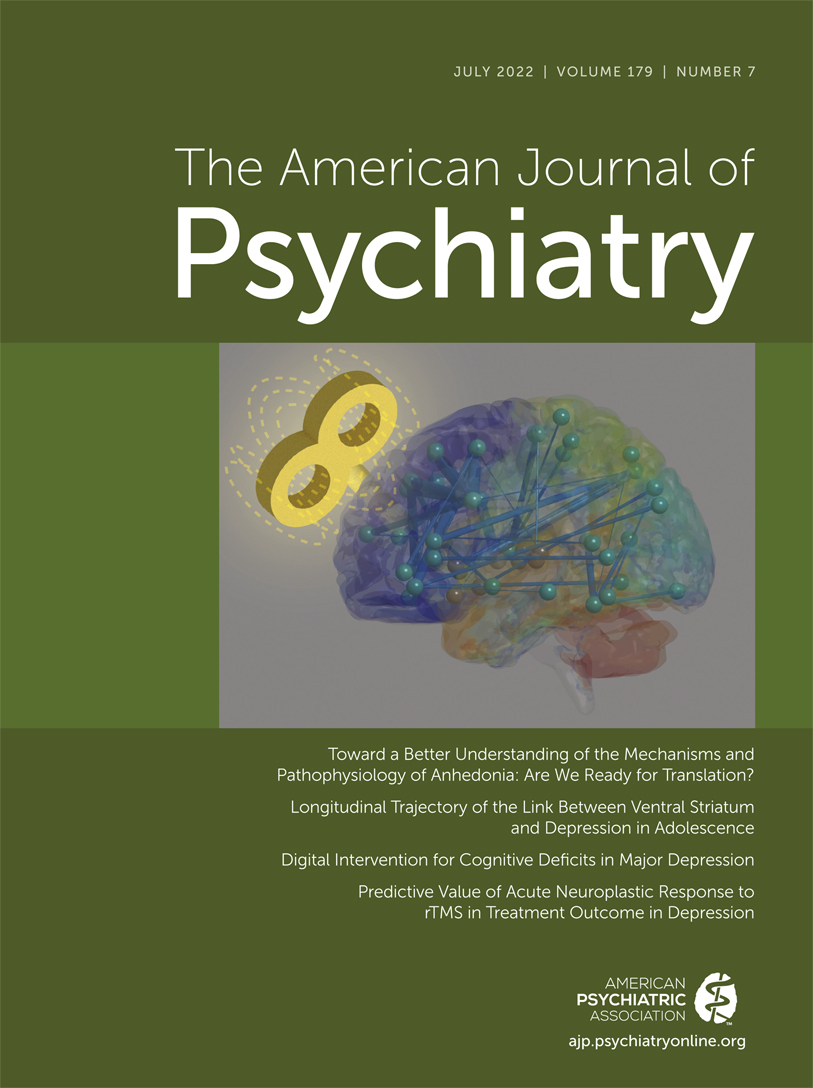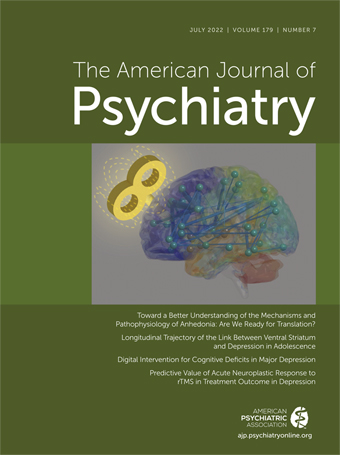The report from Tabuteau et al. (
1) in this issue of the
Journal indicates that the combination of 90 mg of dextromethorphan and 210 mg of bupropion (AXS-05) is significantly more effective than bupropion alone in patients with major depression. The rationale stated is that dextromethorphan is an
N-methyl-
d-aspartate (NMDA) antagonist, and its combination with bupropion promotes higher levels of the parent compound, since the latter acts as a P450-2D6 inhibitor and blocks the rapid conversion to the demethylated metabolite, dextrorphan. Dextromethorphan itself is an NMDA antagonist, but in humans it is rapidly converted to dextrorphan, such that low levels of the parent compound are observed (
2). The rapid conversion of dextromethorphan to dextrorphan is thought to be associated with the potential abuse that has been well reported with dextromethorphan; however, in rodents and monkeys, both the parent and the metabolite are abusable and can substitute for phencyclidine (
3). In humans, much of the drug-seeking revolves around an anticipated dissociative effect and is seen often in adolescents. The combination approach used in the Tabuteau et al. study is akin to a proprietary combination of quinidine with dextromethorphan that is approved by the U.S. Food and Drug Administration (FDA) for pseudobulbar affect, with a similar rationale (
4). In the Tabuteau et al. study, the combination of 90 mg of dextromethorphan with 210 mg of bupropion proved significantly more effective than 210 mg of bupropion alone in major depressive disorder, with separation demonstrated from week 2 to the conclusion of the study at week 6. No effect was seen at 1 week. The response and remission rates were relatively high in the study, and the results hold great promise for many patients with major depression. A New Drug Application has been under review and could be approved soon by the FDA.
There are a number of issues that arise from this combination approach that bear watching over the next few years. First, while this study was positive, a trial in refractory depression (STRIDE-1) in which the combination was compared with bupropion failed to separate at the 6-week point, although separation was observed at weeks 1 and 2 (
5). Thus, the anticipated excitement regarding use of the combination in the refractory depression population needs to be tempered until further clinical experience is gained and more study in patients with treatment-resistant depression is accomplished. Absent those additional data, it is not likely that there will soon be an FDA-approved claim of efficacy in refractory depression that can guide the practitioner.
Another issue has to do with potential abuse liability with prolonged use, particularly in vulnerable populations. Tabuteau et al. cite an unpublished study that reported on 1-year use of the dextromethorphan-bupropion combination in major depression where problems were not observed; however, the details of that study are not clear. Moreover, an at-risk population was not studied, such that more data are needed to assess whether patients with a history of drug abuse are at risk for abusing the combination treatment or whether they may be preferentially responsive. A recent Swiss study (
6) using hair toxicology analysis reported that about 10% of opioid addicts used dextromethorphan. Further, a recent animal study (
7) noted that the dextromethorphan-bupropion combination administered to high-opioid-using rats resulted in the animals reducing their opioid consumption. This could be a plus for the combination as a potential treatment for opioid use disorder, or it could suggest a potential liability in individuals with a history of addiction, who may be prone to misusing the combination. More data addressing this issue are needed in specific human populations.
The science behind the overall antidepressant approach rests heavily on dextromethorphan being an NMDA antagonist and sigma-1 receptor agonist (it also has norepinephrine and serotonin reuptake blocking properties). As noted above, high plasma levels are obtained when dextromethorphan is combined with bupropion, whereas blood levels are low in its absence (
2). However, when the drug is rapidly metabolized in the liver, the demethylated metabolite is formed and is thought to provide rapid dissociative effects. Indeed, dextromethorphan cough syrup is used by addicts and has long been abused by adolescents. What do we really know regarding what happens to the ultimate breakdown and activity of dextromethorphan metabolites when it is given with bupropion? One could conceive of metabolites accumulating over time, which could lead to some abuse or withdrawal potential. These possibilities need to be studied over time in patients. Abuse liability studies in individuals at particular risk need to be performed as well. That the bupropion-quinidine combination has not proven problematic is somewhat reassuring, but more experience will be needed with the dextromethorphan-bupropion combination.
Bupropion at 210 mg/day is within the dosage range that is commonly used in monotherapy of major depression or in combination with another antidepressant in patients with treatment-refractory depression, although it is not the maximum dosage approved for the treatment of major depression. FDA approval of antidepressants traditionally requires significantly greater efficacy as compared with placebo, but superiority over an approved antidepressant is acceptable. This study and those presented to date have not compared the combination to dextromethorphan alone. The rationale is that dextromethorphan alone is so rapidly metabolized that the blood levels achieved are minuscule and not particularly relevant. However, those studies would help answer the question of whether the bupropion is enhancing the antidepressant effects via changing drug metabolism or acting as a combination of two potential antidepressants. Comparing combination drugs with their individual components has long been the approach of the FDA in evaluating combination compounds, but that was not done here, perhaps because dextromethorphan has not been thought to be an antidepressant. But do we know that for sure? Do we know that the active metabolite, dextrorphan, is itself not an antidepressant? In the literature there appears to be little in the way of controlled studies in humans (
8). In contrast, there is a strong literature on dextromethorphan abuse (
9). To this eye, there is a gap in the development of the compound that needs to be addressed in the near future to evaluate the rationale for using the combination.
NMDA antagonism has been the focus of recent antidepressant drug development for ketamine and related compounds, but its emphasis has been an area of considerable debate and concern regarding how important that mechanism of action actually is for antidepressant efficacy. I have argued that NMDA antagonism is likely not the key factor for ketamine’s rapid antidepressant effect, but rather mu-opioid agonism or endogenous opioid release might explain it better (
10,
11). My colleagues and I demonstrated that naltrexone blocked ketamine’s antidepressant effects under double-blind conditions but did not block its dissociative symptoms (
11). This finding has now been supported by several preclinical reports. Recently, a report from investigators at the National Institute on Drug Abuse indicated that esketamine exerts similar micromolar binding to NMDA receptors as to mu-opioid receptors (
12). In that rodent study, mu-opioid blockers (naltrexone and naloxone) blocked the behavioral effects of esketamine. Moreover, in that study rodents self-administered esketamine more than
R-ketamine. These results, coupled with ours in humans, should give us pause regarding the safety of many of the NMDA antagonists. Indeed, ketamine is highly abusable. Moreover, we recently saw the report on the very rapid and short-term antidepressant effects of
d-methadone, supposedly a safer and less abusable methadone (
13). But the data to date are not fully convincing as to the safety of that agent (as nicely discussed by Nemeroff in an editorial [
14]), and it is not clear whether there will be issues related to more prolonged use. Hopefully, these issues will not be a problem for the dextromethorphan-bupropion combination.
Where the opioid mediation may come in with NMDA antagonists is in the rapidity of response. With ketamine, esketamine, and
d-methadone, we see very rapid effects that appear different from those seen with the dextromethorphan-bupropion combination, where, in this study, separation from bupropion alone was seen at 2 weeks, suggesting a different mechanism of action. We need to better understand how the NMDA receptor may interact with opioid receptors and endogenous opioid release to get a handle on safe drug development in this area. Using naltrexone to attempt to block the antidepressant effect of the dextromethorphan-bupropion combination would be one way of interrogating this issue. It is not necessarily a bad thing that some NMDA-receptor-modulating agents also have effects on mu-opioid receptors and/or release, but the field needs answers regarding potential risks to balance the potential benefits for individual patients. In the end, this report by Tabuteau et al. (
1) is an advance in developing oral antidepressants that are relatively rapidly effective and that have putative mechanisms of action of working through NMDA antagonism.

